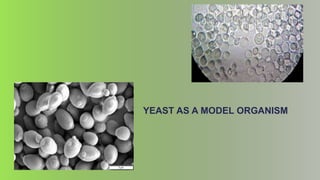
Yeast
- 1. YEAST AS A MODEL ORGANISM
- 2. INTRODUCTION • Unicellular, eukaryotic organism,belonging to fungi • Charecterized as single cells that divide by budding • Commonly used to ferment the sugars of rice,barley, wheat and corn to produce alcoholic beverages • Yeast was the first eukaryotic organism to have its genome sequenced. • Yeast chromosomes share a number of important features with human chromosomes.
- 3. Why yeast is used as model organism? • Simple to grow • Replicates rapidly • High progeny numbers • Easy to maintain • Easy storage and can be frozen for later use • Can be genetically modified • No ethics approval required • Complete genome sequence available since 1996
- 4. Charecteristics 1)Simplest organization: • Yeast is a simplest eukaryotic organism. • Cell wall consisting of glucans, mannans and proteins • Periplasmic space with hydrolytic enzymes • Plasma membrane consisting of a phospholipid bilayer and many different proteins • Nucleus with nucleolus • Vacuole as storage and hydrolytic organelle • Secretory pathway with endoplasmic reticulum, Golgi apparatus and secretory vesicles
- 5. • Peroxisomes for oxidative degradation • Mitochondria for respiration
- 6. 2. Genomic study model: • In 1996, Saccharomyces cerevisiae become first eukaryotic organism whose genome is fully sequenced. • Yeast nuclear genome has 16 chromosomes. • Yeast genome is approximately three times larger than that of E. coli, although it is far more manageable than the genomes of more complex eukaryotes, such as humans. • The yeast chromosomes contain both centromeres and telomeres sequence. • Only a small percentage of yeast genes has introns; non coding sequence of RNA transcript.
- 7. 3. Contains extra chromosomal DNA: •Yeast contains extra chromosomal double stranded circular plasmid DNA. •More than one plasmid can be transformed in a yeast cell at a time. 4. Economic: Yeast are easy to culture and maintain in laboratory environment
- 8. 5. Short generation time compared to other higher organisms. 6. Experimental study model: • Gene manipulation is not complicated. • Many fundamental aspects of eukaryotic cell such as DNA replication, transcription, translation, mutation, etc are understand on the basis of yeast study • Yeast can be “transformed” with replicating plasmids. Transformation is efficient, although not as efficient as in E. coli.
- 9. 7. Yeast consists of both haploid and diploid form S. cerevisia:e has two vegetative stages, haploids and diploids • The haploid yeast genome consists of about 12,500 kbp • Haploid and diploid form are interchangeable. Mating pairs of haploid cells fused to give diploid cell, while diploid cell on sporulation gives haploid cell. This makes genetic study easier. An exogenous DNA can be easily integrated into yeast genome.
- 10. Yeast cell cycle
- 11. In the G1 phase of the cycle, the yeast cell has three options It can complete the cycle and divide It can leave the cycle, if nutritionally starved, where it is resistant to heat and chemical treatment It can mate with a cell of opposite sex, if haploid, after a transient arrest in G1. It can undergo meiosis to produce four haploid cells under nutritional starvation, if diploid
- 13. Yeast, the cell cycle and cancer: In 2001, three scientists shared the Nobel Prize for their independent work establishing the role of different genes in controlling the cell cycle and investigating the link between the cell cycle in yeast and that in humans. These three scientists were Leland Hartwell, Paul Nurse and Tim Hunt.
- 14. Leland Hartwell, a biologist, was one of the first scientists to discover some of the mutations involved in cancer. Through his work he found that the genes involved in the ‘cell division cycle’ (CDC) in S. cerevisiae yeast, were also found, in more or less the same capacity, in humans. Paul Nurse followed Leland’s example but this time using S. pombe yeast to explore the control of cell division. In the middle of the 1970s he discovered a gene in S. pombe yeast called cdc2 and found that it had a key role in controlling cell division. In 1987 he then found the equivalent gene in humans which was later given the name Cdk1. This then led to the discovery of other CDK molecules involved in controlling cell division in humans.
- 15. During the early 1980s, while studying sea urchins, Tim Hunt discovered cyclin, a protein formed and then broken down during each cell division. It was found that cyclins bind to the CDK molecules, discovered by Paul Nurse, and switch them on during the control of cell division. He also showed that these cyclins are degraded at each cell division, a mechanism proved to be of huge importance for controlling the process.
- 16. Yeast and Parkinson’s disease Parkinson’s disease and other neurodegenerative diseases such as Alzheimer’s and Huntington’s are characterised by protein misfolding, resulting in the build-up of toxic cells in the central nervous system. Cellular build-up of the protein, α-synuclein, is known to greatly increase a person’s risk of developing Parkinson’s disease and is also found to affect yeast. Similarly, when engineered to produce high levels of α-synuclein, S. cerevisiae cells show signs of signs of damage and their growth becomes slower. Knowing this, scientists have been able to use S. cerevisiae as an effective tool to characterise factors and mechanisms that regulate α-synuclein toxicity.